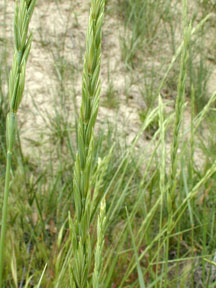WESTERN WHEATGRASS
|
 |
| File Size: 79 KB |
|
|
|
Pascopyrum smithii (Rydb. ) A. Löve
|
| [=Agropyron smithii Rydb.] |
| Cheyenne County, Kansas |
| Perennial |
| Height: 1-3 feet |
| Family: Poaceae - Grass Family |
| Flowering Period: June, July, August, September |
|
| Culms: | | Erect, solitary or in small clusters, hollow, waxy, glabrous. | | Blades: | | Flat or rolled inward, 4 to 10 inches long, to 1/4 inch wide, rigid, bluish green waxy, rough above, prominently veined; tips tapered to sharp points. | | Sheaths: | | Shorter than internodes, open, glabrous or rough; auricles conspicuous. | | Ligules: | | Short, membranous, notched or minutely fringed. | | Inflorescences: | | Spikes, erect, 2-sided, 3 to 8 inches long. | | Spikelets: | | Solitary or sometimes 2 per node, flattened, waxy, 1/2 to 1 inch long, overlapping, 3-12-flowered; glumes unequal; glume and lemma tips pointed, occasionally awned. | | Habitat: | | Moist to dry prairies, waste areas, ditch banks and roadsides, most abundant in fine-textured alkaline soils. | | Distribution: | | Throughout Kansas. | | Forage Value: | | Western wheatgrass is nutritious for livestock and is readily grazed during the early growth stage. It makes good quality, high-protein hay when cut during the late-bloom stage. | | Comments: | | Western wheatgrass is strongly rhizomatous and often forms loose sod. It produces seed in the spring and goes dormant in mid-summer. It sometimes grows again in the fall if soil moisture is adequate |
|
| Western wheatgrass |  | | 168 KB | | Mitchell County, Kansas |
| | Western wheatgrass |  | | 83 KB | | Mitchell County, Kansas |
| | Western wheatgrass |  | | 148 KB | | Cheyenne County, Kansas |
| | Western wheatgrass flowering |  | | 123 KB | | Konza Prairie, Riley County, Kansas |
| | Western wheatgrass anthers |  | | 74 KB | | Konza Prairie, Riley County, Kansas |
| |
|
|
|
|
|
|







